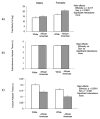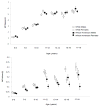Ethnic and sex differences in visceral, subcutaneous, and total body fat in children and adolescents
- PMID: 23670982
- PMCID: PMC3735659
- DOI: 10.1002/oby.20210
Ethnic and sex differences in visceral, subcutaneous, and total body fat in children and adolescents
Abstract
Objective: This study investigated ethnic and sex differences in the distribution of fat during childhood and adolescence.
Design and methods: A cross-sectional sample (n = 382), aged 5-18 years, included African American males (n = 84), White males (n = 96), African American females (n = 118), and White females (n = 84). Measures for total body fat (TBF) mass and abdominal adipose tissue (total volume and L4-L5 cross-sectional area) for both subcutaneous adipose tissue (SAT) and visceral adipose tissue (VAT) depots were assessed by dual-energy X-ray absorptiometry and magnetic resonance image, respectively. Analyses of covariance (ANCOVAs) were used to determine ethnic and sex differences in TBF (adjusted for age) and ethnic and sex differences in SAT and VAT (adjusted for both age and TBF).
Results: Age-adjusted TBF was greater in African Americans (P = 0.017) and females (P < 0.0001) compared with Whites and males, respectively. In age- and TBF-adjusted ANCOVAs, no differences were found in the SAT. The VAT volume was, however, greater in Whites (P < 0.0001) and males (P < 0.0001) compared with African Americans and females, respectively. Similar patterns were observed in SAT and VAT area at L4-L5.
Conclusions: The demonstrated ethnic and sex differences are important confounders in the prevalence of obesity and in the assignment of disease risk in children and adolescents.
Copyright © 2013 The Obesity Society.
Conflict of interest statement
Figures


References
-
- Owens S, Gutin B, Ferguson M, Allison J, Karp W, Le NA. Visceral adipose tissue and cardiovascular risk factors in obese children. J Pediatr. 1998;133:41–45. - PubMed
-
- Matsuzawa Y, Funahashi T, Nakamura T. The concept of metabolic syndrome: Contribution of visceral fat accumulation and its molecular mechanism. J Atheroscler Thromb. 2011;18:629–639. - PubMed
-
- Huang TT, Johnson MS, Figueroa-Colon R, Dwyer JH, Goran MI. Growth of visceral fat, subcutaneous abdominal fat, and total body fat in children. Obes Res. 2001;9:283–289. - PubMed
-
- Lee S, Kuk JL, Hannon TS, Arslanian SA. Race and gender differences in the relationships between anthropometrics and abdominal fat in youth. Obesity. 2008;16:1066–1071. - PubMed
Publication types
MeSH terms
Grants and funding
LinkOut - more resources
Full Text Sources
Other Literature Sources
Medical
Research Materials

